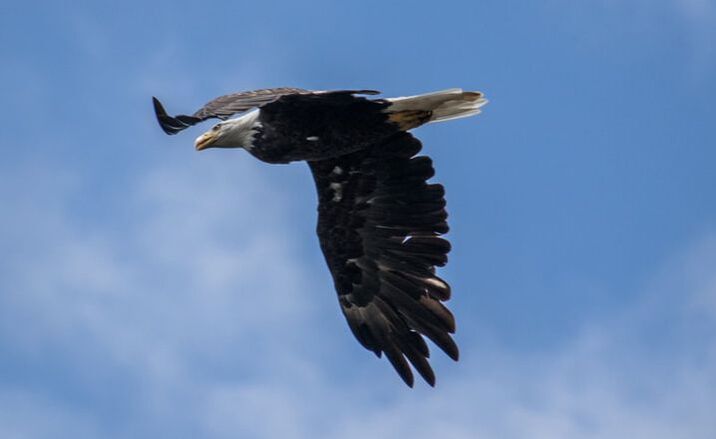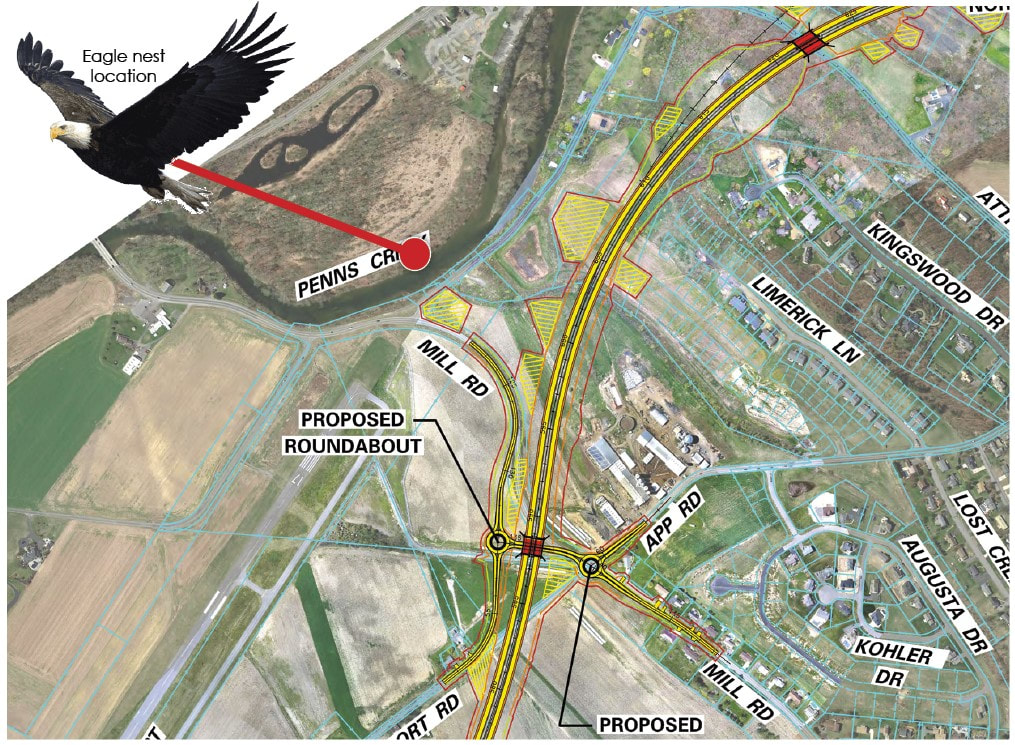PennDOT takes steps to minimize impact on active eagle nest near Thruway's southern construction4/29/2022 As bald eagles returned to a Snyder County nest along the Penns Creek earlier this spring, the Middle Susquehanna Riverkeeper Association and several local concerned citizens reached out to the Pennsylvania Department of Transportation to see what impacts this may have on construction activities for the nearby southern section of the Central Susquehanna Valley Thruway project. “We will continue to coordinate with the PA Game Commission and the US Fish and Wildlife Service as the CSVT Project proceeds, but the first measure we are taking is that we will not perform any construction activity within 660 feet of the nest,” reported Noah Bauer, project manager of PennDOT’s Engineering District 3-0’s design unit. “This is the US Fish and Wildlife Service’s standard recommendation as a buffer to protect eagles from the visibility and noise of typical construction activities.” Tthe 660-foot buffer comes from the National Bald Eagle Management Guidelines issued in 2007 by the Fish and Wildlife Service. Beyond that buffer, in this specific case, Bauer relayed that other steps will be followed to minimize impact on eagle activities at the nest.
“We are also restricting blasting from January 1 to April 30 within a half-mile of the nest to protect the eagles from loud and intense noise during the laying, incubation and brooding phases of their breeding season,” he said, adding that officials will be doing noise analysis studies. “We are performing a noise analysis to get a better understanding of what the noise level will be at the nest during blasting operations in that area, since these particular eagles may be more accustomed to loud noises with their nest being located at the end of the runway for the Penn Valley Airport,” he said. “If the results of the noise analysis show the noise at the nest from blasting to be lower than the noise the eagles are accustomed to, and if the US Fish and Wildlife Service and Pennsylvania Game Commission concur, we may ultimately allow blasting in March and April.” PennDOT’s efforts to protect the active eagle nest as preparations are made for the southern section’s construction to begin are “very reasonable,” according to Dan Brauning, the recently retired supervisor of the Pennsylvania Game Commission’s Wildlife Diversity Program and a major force in helping restore populations of eagles, ospreys and peregrine falcons across the state over the past few decades. “Eagles are not the birds of pristine wilderness that we once thought. Just think about the number of nests that are literally within feet of an active highway,” he said. “They are somewhat sensitive to a person on foot close to the nest, but we have to get past the idea that they are endangered. They're not anymore.” Bauer’s response suggests that PennDOT is following “federal guidance to a tee,” Brauning added. “That provides a pretty generous protection of 660 feet, but allows for the individual variation that we'd expect in nature. Blasting is pretty disruptive, but birds can adapt to even that!” The nest, located on the edge of a small wetland built by PennDOT decades ago to mitigate impacts of widening US 11 south of Selinsgrove in the late 1980s/early 1990s, is visible from sections of Mill Road where construction is scheduled, as well as Route 204. “The state bought land so that it always, in perpetuity, will stay a wetland,” said Bob Garrett, president of the Greater Susquehanna Valley Chamber of Commerce. "We all agree there can be no net loss of wetlands for a myriad of reasons, including flood mitigation and their value in recharging aquifers. Because of the work done decades ago on this project, we actually will have a net-increase of wetland acres in our aqui-district." Bald eagles were listed as endangered in 1972, and it was in the late 90s that they were removed from the endangered species list nationally. “In more recent years, they came off the state’s list,” said Brauning, adding that more recently, populations across the state, and regionally, have skyrocketed. “I never imagined we would have them as widespread as we do today, especially since these species were at the brink of extinction. At least regionally, they were really gone,” he said. “It took a long and steady dedicated effort to successfully bring them back to their ecological place in our region. The very fact that that we have been able to bring these birds – or any animal – back from the brink is really heartening. It shows us that a dedicated effort can be successful and is not a waste of time.” Along those lines, however, Brauning urges caution in how people respond to nests in their neighborhoods. “The psychology – if you can talk about psychology in eagles – is that they can accommodate a lot of routine human activity, like traffic and construction projects that are done mindfully of state and federal guidelines. However, when a human actively approaches a nest on foot, it can be perceived as an immediate threat, even if that human just is out with a camera,” said Brauning. “It is important to keep our distance and not get to a point where eagles are visibly disturbed and leaving the nest.”
0 Comments
Leave a Reply. |
AuthorsRiverkeeper John Zaktansky is an award-winning journalist and avid promoter of the outdoors who loves camping, kayaking, fishing and hunting with the family. Archives
April 2024
Topics |


 RSS Feed
RSS Feed